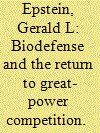|
|
|
Sort Order |
|
|
|
Items / Page
|
|
|
|
|
|
|
| Srl | Item |
| 1 |
ID:
182961


|
|
|
|
|
| Summary/Abstract |
The 2017 US National Security Strategy asserts that, “after being dismissed as a phenomenon of an earlier century, great power competition returned,” pointing to actions that Russia and China have taken to reassert their influence and attempt to change the international order. Such a shift has implications for biodefense. It suggests an increased likelihood of the development and potential use of biological weapons by states, which had been downplayed by those who have been more concerned about non-state biological-weapons programs. State program access to expertise, facilities, and resources implies a greater level of technological sophistication than would typically be credited to non-state actors, influencing the requirements for national biodefense programs to detect, characterize, respond, to, and attribute a biological attack. States also could have missions for biological weapons that differ from those intended by terrorists.
|
|
|
|
|
|
|
|
|
|
|
|
|
|
|
|
| 2 |
ID:
126143


|
|
|
|
|
| Publication |
2012.
|
| Summary/Abstract |
The dual-use dilemma in the life sciences-that illicit applications draw on the same science and technology base as legitimate applications-makes it inherently difficult to control one without inhibiting the other. Since before the September 11 attacks, the science and security communities in the United States have struggled to develop governance processes that can simultaneously minimize the risk of misuse of the life sciences, promote their beneficial applications, and protect the public trust. What has become clear over that time is that while procedural steps can be specified for assessing and managing dual-use risks in the review of research proposals, oversight of ongoing research, and communication of research results, the actions or decisions to be taken at each of these steps to mitigate dual-use risk defy codification. Yet the stakes are too high to do nothing, or to be seen as doing nothing. The U.S. government should therefore adopt an oversight framework largely along the lines recommended by the National Science Advisory Board for Biosecurity almost 5 years ago-one that builds on existing processes, can gain buy-in from the scientific community, and can be implemented at modest cost (both direct and opportunity), while providing assurance that a considered and independent examination of dual-use risks is being applied. Without extraordinary visibility into the actions of those who would misuse biology, it may be impossible to know how well such an oversight system will actually succeed at mitigating misuse. But maintaining the public trust will require a system to be established in which reasonably foreseeable dual-use consequences of life science research are anticipated, evaluated, and addressed.
|
|
|
|
|
|
|
|
|
|
|
|
|
|
|
|
|
|
|
|
|